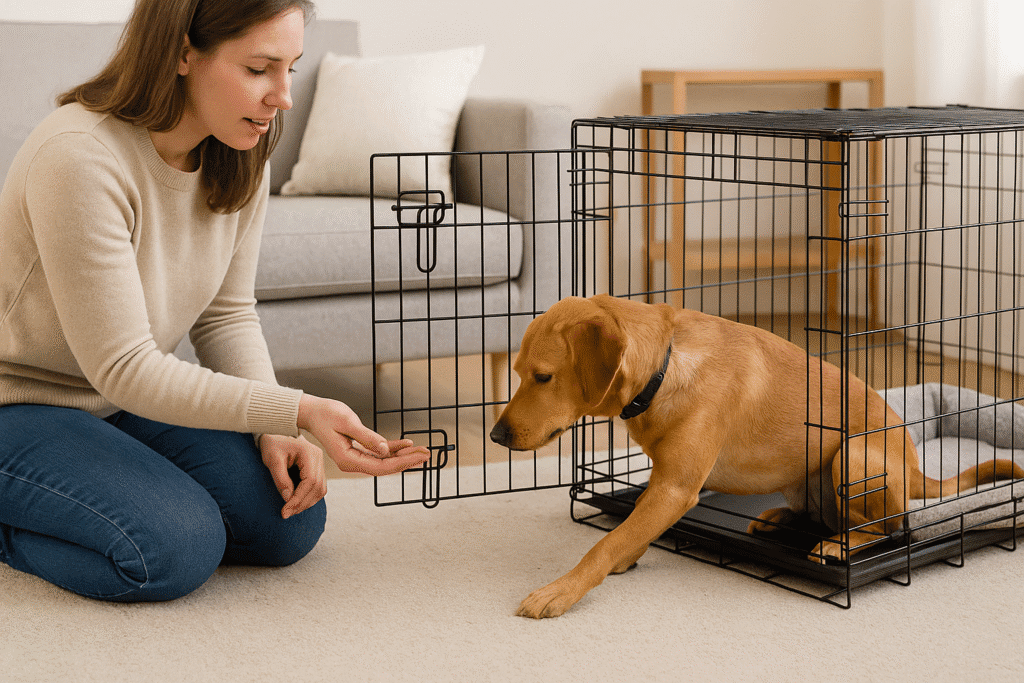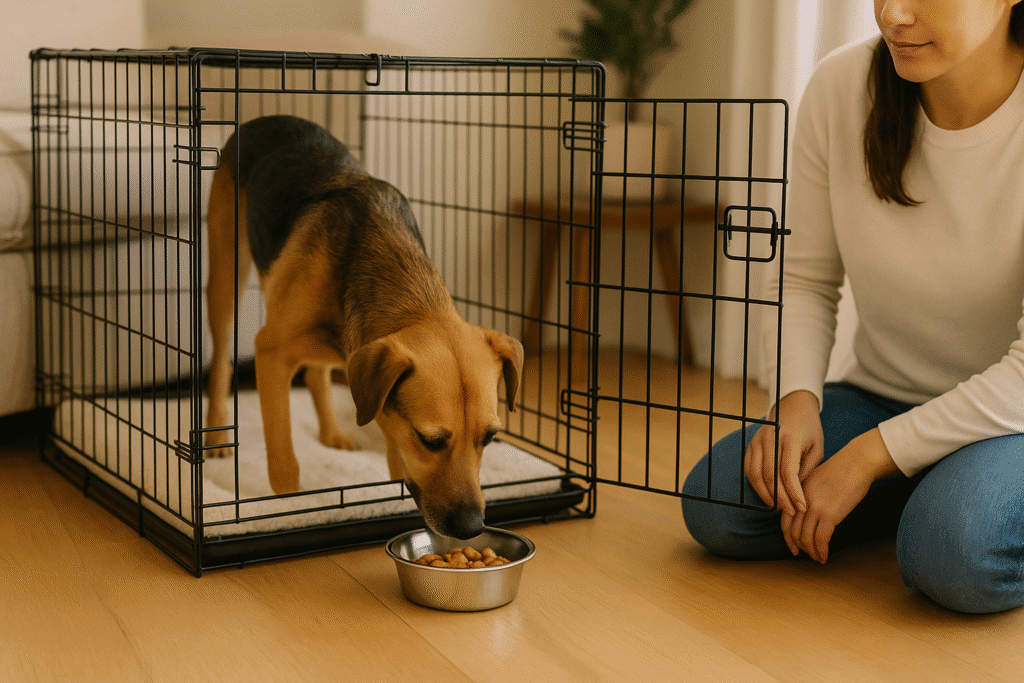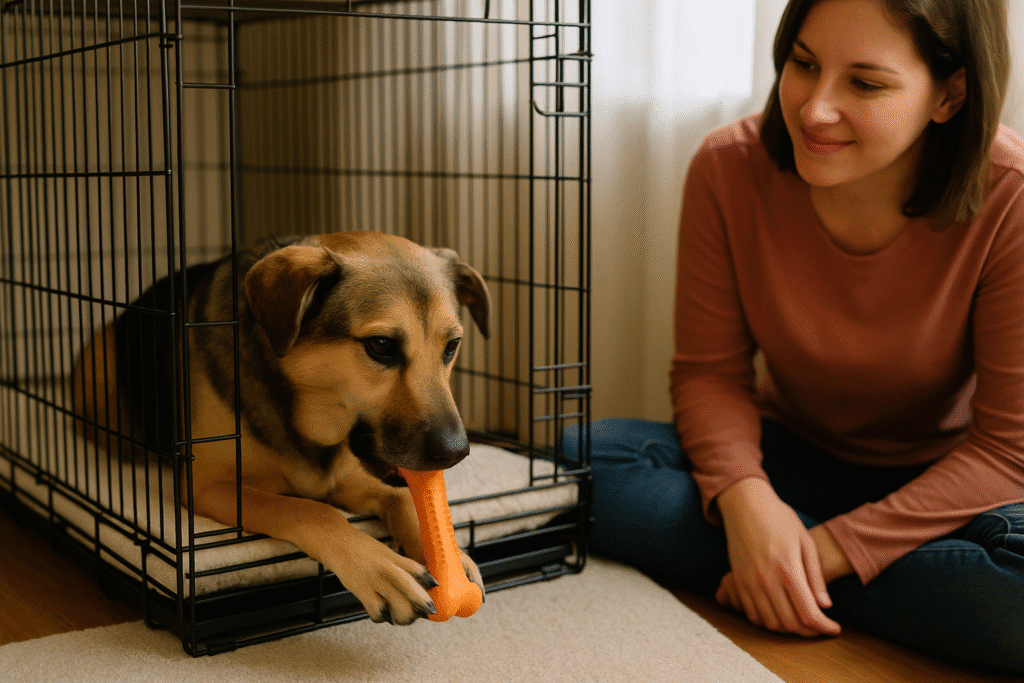Discover how to crate train a rescue dog using gentle, step-by-step methods. This guide explains how to reduce anxiety, create a safe space, and build trust with your adopted pet. With patience and consistency, you’ll help your rescue dog thrive in a new home.
Introduction to Crate Training a Rescue Dog
Crate training is one of the most effective tools for helping adopted pets transition into a safe, structured environment. But learning how to crate train a rescue dog requires patience, empathy, and consistency. Unlike puppies raised in one home, rescue dogs may come with unique experiences or fears. This makes it essential to introduce the crate as a positive, safe space rather than punishment.

Why the Best Approach to Crate Train a Rescue Dog Matters
Many rescue dogs have uncertain backgrounds. Some may have been neglected, abandoned, or never crate-trained before. Understanding how to crate train a rescue dog properly helps establish trust and reduces anxiety. Done correctly, crate training creates a secure environment where your dog can relax, aids in house training, and prevents destructive behavior when you’re not around.
Benefits of Crate Training for Rescue Dogs
- Provides a personal safe space for rest
- Helps with housebreaking and accident prevention
- Reduces destructive behaviors like chewing
- Supports travel safety and vet visits
- Builds a foundation of trust and structure
Preparing to Crate Train a Rescue Dog
Before beginning, you need the right setup and mindset. Choosing the right crate, placing it in the proper spot, and setting realistic expectations are essential when learning how to crate train a rescue dog.
Choosing the Right Crate
Pick a crate large enough for your dog to stand, turn, and lie down comfortably. Wire crates offer ventilation, while plastic crates can feel more den-like for anxious dogs.
Creating a Positive Environment
Place the crate in a calm area of the house. Add soft bedding, safe chew toys, and perhaps a blanket over the top for a cozy feel. Never use the crate as punishment—this will harm your efforts to successfully crate train a rescue dog.
Step-by-Step Guide: How to Crate Train a Rescue Dog
The key to success is gradual exposure, positive reinforcement, and consistency. Below is a proven process for how to crate train a rescue dog.
Step 1: Introduce the Crate Positively
Leave the crate door open and allow your rescue dog to explore at their own pace. Toss treats inside and praise them when they enter. This builds curiosity and trust.
Step 2: Feed Meals Inside the Crate
Feeding your rescue dog inside the crate reinforces positive associations. Start with the bowl near the entrance and gradually move it further inside.
Step 3: Practice Short Sessions
Once comfortable entering, encourage your dog to stay inside briefly with the door closed. Reward calm behavior with praise or treats. Keep sessions short—just a few minutes at first.
Step 4: Extend Crate Time
Gradually increase the time your dog spends in the crate, adding comfort items like a chew toy. Stay nearby at first to reassure them, then begin leaving the room for short periods.
Step 5: Use the Crate for Sleep and Alone Time
When your rescue dog is comfortable, begin using the crate overnight or when leaving home. This consistency helps them see the crate as a safe, routine space.

Overcoming Challenges When You Crate Train a Rescue Dog
Not all rescue dogs adjust quickly. Some may whine, bark, or resist the crate. It’s important to respond with patience and avoid punishment.
Dealing with Anxiety
Dogs with separation anxiety may need extra reassurance. Gradually extend crate time, provide calming toys, or consider anxiety-reducing aids with your vet’s guidance.
Addressing Whining and Barking
If your dog vocalizes, wait until they are calm before opening the crate. Reward quiet, relaxed behavior to avoid reinforcing noise.
Rescue Dogs with Trauma
Some rescue dogs may have negative past experiences with confinement. In these cases, go slower, use high-value rewards, and keep the crate door open longer during training.
Tips to Successfully Crate Train a Rescue Dog
- Be patient and consistent—progress may be slower than with puppies
- Use positive reinforcement and avoid punishment
- Keep crate time balanced with play, walks, and bonding
- Ensure your rescue dog gets enough exercise before crate sessions
- Always provide fresh water and safe chew toys

Frequently Asked Questions (FAQ)
- How long does it take to crate train a rescue dog?
Each dog is different. Some adjust in days, while others may take weeks or longer. - Is it cruel to crate train a rescue dog?
No, when done properly crate training provides safety and comfort, not punishment. - Should I cover the crate with a blanket?
Yes, covering part of the crate can make it feel den-like and reduce anxiety, but ensure proper ventilation. - Can an older rescue dog be crate trained?
Absolutely. Older dogs may take longer to adapt, but with patience, they can learn successfully. - What if my rescue dog panics in the crate?
Go slower, use higher-value rewards, and consult your vet if anxiety persists.
Conclusion
Learning how to crate train a rescue dog takes time, empathy, and consistency. With positive reinforcement, patience, and gradual exposure, you can help your rescue dog see the crate as a safe haven. The effort you put in will pay off with a calmer, more secure companion who thrives in their forever home.
👉 See more dog training guides here
(Internal link: For more puppy training tips, see our House Training Puppies Guide.)
(Internal link: Learn about anxiety solutions in our Separation Anxiety in Dogs Guide.)
(Outbound link: Read veterinary advice on crate training from ASPCA General Dog Care.)


핑백: Great Pyrenees Care Guide: The Gentle Giant You’ll Instantly Fall For